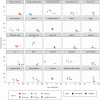Rewilding the world's large carnivores
- PMID: 29657815
- PMCID: PMC5882739
- DOI: 10.1098/rsos.172235
Rewilding the world's large carnivores
Erratum in
-
Correction to 'Rewilding the world's large carnivores'.R Soc Open Sci. 2018 May 2;5(5):180514. doi: 10.1098/rsos.180514. eCollection 2018 May. R Soc Open Sci. 2018. PMID: 29893379 Free PMC article.
Abstract
Earth's terrestrial large carnivores form a highly endangered group of species with unique conservation challenges. The majority of these species have experienced major geographical range contractions, which puts many of them at high risk of extinction or of becoming ecologically ineffective. As a result of these range contractions and the associated loss of intact predator guilds, the ecological effects of these species are now far less widespread and common, with inevitable consequences for ecosystem function. Rewilding-which includes reintroducing species into portions of their former ranges-is an important carnivore conservation tool and means for restoring top-down ecological regulation. We conducted a global analysis of potential reintroduction areas. We first considered protected areas where one or more large carnivore species have been extirpated, identifying a total of 130 protected areas that may be most suitable for carnivore reintroduction. These protected areas include sites in every major world region, and are most commonly found in Mongolia (n = 13), Canada (n = 11), Thailand (n = 9), Namibia (n = 6), Indonesia (n = 6) and Australia (n = 6). We considered the sizes of protected areas, their levels of protection, the extent of human impacts within and around the protected areas, and the status of prey species in the protected areas. Finally, we used the 'last of the wild' approach to identify contiguous low human footprint regions within the former ranges of each species, identifying an additional 150 areas which could be the focus of conservation efforts to create conditions conducive to reintroductions. These low footprint regions were most commonly found in the USA (n = 14), Russia (n = 14), Canada (n = 10), China (n = 9) and Mauritania (n = 8). Together, our results show the global-scale potential for carnivore rewilding projects to both conserve these species and provide critical ecological and social benefits.
Keywords: carnivore guild; ecological effectiveness; geographical range; intact guild; predator; reintroduction.
Conflict of interest statement
We declare we have no competing interests.
Figures





Comment in
-
Reintroducing apex predators: the perils of muddling guilds and taxocenoses.R Soc Open Sci. 2018 Jul 11;5(7):180567. doi: 10.1098/rsos.180567. eCollection 2018 Jul. R Soc Open Sci. 2018. PMID: 30109104 Free PMC article. No abstract available.
References
-
- Gittleman JL, Funk SM, Macdonald DW, Wayne RK (eds). 2001. Carnivore conservation, 1st edn Cambridge, UK: Cambridge University Press.
-
- Hayward MW, et al. 2007. Practical considerations for the reintroduction of large, terrestrial, mammalian predators based on reintroductions to South Africa's Eastern Cape Province. Open Conserv. Biol. J. 1, 1–11. (doi:10.2174/1874839200701010001) - DOI
-
- Hayward MW, Somers M. 2009. Reintroduction of top-order predators. New York, NY: John Wiley & Sons.
-
- Castellanos A, Altamirano M, Tapia G. 2005. Ecología y comportamiento de osos andinos reintroducidos en la Reserva Biológica Maquipucuna, Ecuador: implicaciones en la conservación. Revista Politécnica 26, 54–82.
-
- Kim Y-K, et al. 2011. Genetic status of Asiatic black bear (Ursus thibetanus) reintroduced into south Korea based on mitochondrial DNA and microsatellite loci analysis. J. Hered. 102, 165–174. (doi:10.1093/jhered/esq121) - DOI - PubMed
Associated data
LinkOut - more resources
Full Text Sources
Other Literature Sources
Research Materials

